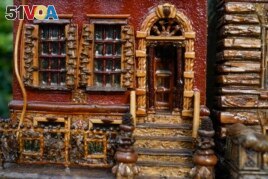26 November 2021
In the United States, small train displays are one of the most popular attractions during the holiday season.
They used to be common in toy store windows. Now they are seen in many public places, such as at plant shows, exhibits and museums.
One kind of display, however, is special. In these displays, the model structures are made from leaves, sticks and other dried plant materials. This creates a different kind of magic and whimsy.
"It's magical because people love to picture themselves in these small landscapes," Karen Daubmann told the Associated Press. She oversees exhibitions and public events at the New York Botanical Garden in New York City.

A miniature brownstone building is displayed during preparations for the annual Holiday Train Show in New York City, November 11, 2021.
Daubmann added that the "displays of greenery hide whimsical elements surrounding the models of trains" and decorated structures.
New York Botanical Garden first used this kind of train display back in 1992. But this unique style did not begin in New York City. It began in the Midwestern state of Ohio.
Almost 40 years ago, Ohio landscape architect Paul Busse found a way to share his love of trains, architecture and gardens with the public. He set up a garden railway exhibit at the 1982 Ohio State Fair. He decorated the buildings with dried plant material. He called it his "botanical architecture."
Throughout the 1980s, Busse developed his whimsical structures. In 1991, he launched his own company. He ran Applied Imagination out of his basement in Cincinnati, Ohio. His botanical architecture train displays appeared at garden shows, mainly in the Midwest.
Then in 1992, the New York Botanical Garden invited Busse and his team to create a "Holiday Train Show." The organization wanted winter visitors to enjoy what was already popular in many Midwestern towns and cities.
"That first year it only featured a couple train tracks and a handful of models of New York landmarks," said Daubmann. But she said it was such a success that it became a yearly tradition. Each year they would add new landmarks, such as a famous building or place in New York City.
The idea soon spread. And more places wanted to copy their landmarks in botanical architecture.
Busse soon ran out of space in his basement. He moved his company to Alexandria, Kentucky, where it is now based. The company has about 12 full-time employees. Busse's daughter, Laura Busse Dolan, now runs the business.
What natural materials they use
Dolan described the materials her group uses to the Associated Press.
She said they use different kinds of sticks, pinecones and other plant pieces. Over the years, the company has learned not to use some kinds of fruits and nuts.
"We now avoid using dried berries or acorns in our structures because they are far too edible," Dolan said. They had a problem with little creatures eating the structures while they were stored. "One year, the squirrels ate one of our lampposts."
The shows are now a tradition in many U.S. cities. They show a combination of model trains and detailed models of famous buildings and landmarks.
Last year, many holiday-season train shows were canceled or limited to fewer visitors because of the coronavirus pandemic. But this year the popular offerings are back at gardens and other places around the country.
Dolan's teams are putting together nine holiday shows this year.
To create all the shows, Dolan said the teams at Applied Imagination leave home in October and travel until Thanksgiving.
It takes every individual in the company to finish the displays. Dolan said that every year the company creates about 50 structures for different places. She estimates the company has made between 2,000 to 3,000 total structures since it started. "The smaller ones take around 250 hours," she said.
However, one of their largest is a copy of the Biltmore Estate in Asheville, North Carolina, more than three meters in size. That structure took nearly 3,000 hours to complete. "It is on display at the Biltmore Estate through the holidays this year," Dolan said.
On the website for Applied Imagination, Paul Busse credits his mother for his work. Jane Busse, the website says, "was a gifted artist." Her work has been celebrated at The Smithsonian and The Cincinnati Art Museum.
The website goes on to explain that Jane liked a famous, costly home in the area called Carson Mansion. She liked it so much that the year her son Paul was born, 1949, she made a small version using very strong paper and matchsticks.
To honor his mother, Paul made his own version of the Carson Mansion using his own botanical architectural design.
I'm Anna Matteo.
And I'm Dorothy Gundy.
Katherine Roth reported this story for the Associated Press. Anna Matteo adapted it for VOA Learning English. Mario Ritter, Jr. was the editor.
__________________________________________________
Words in This Story
display –n. an arrangement of objects intended to decorate, advertise or inform people about something : v.
exhibit –n. an object or a collection of objects that have been put out in a public space for people to look at; something shown in an exhibition : v.
whimsy –n. a playful, humorous or funny quality
landscape –n. an area of land that has a certain quality or appearance that is sometimes designed by people
decorated –adj. an added design or object meant to make something else look more pleasing or interesting
unique –adj. unlike anything else
architect –n. a person who designs buildings
featured –adj. having or including something as an important part
couple –n. two or a few examples of something
matchstick –n. a slender piece especially of wood from which a match is made